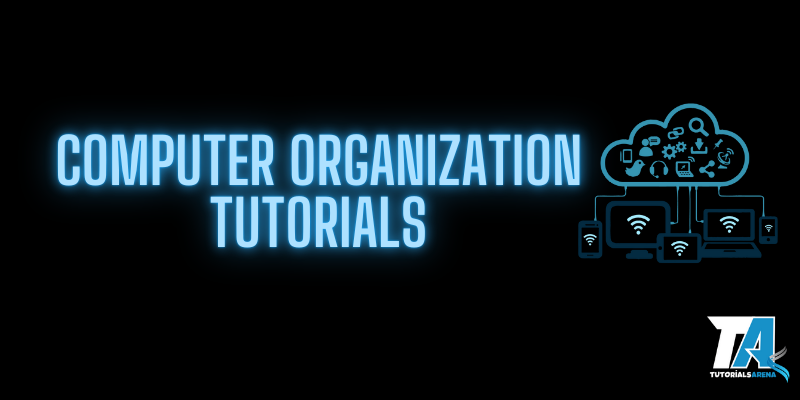Computer Organization and Architecture Tutorial | COA Basics & Concepts
Explore our Computer Organization and Architecture (COA) Tutorial, covering the internal working, structuring, and implementation of computer systems. Learn about computer components, memory hierarchy, instruction sets, I/O systems, pipelining, and CPU architecture. Ideal for beginners and professionals, this guide helps you understand how computer systems are designed and function.

Computer Organization and Architecture Tutorial
This tutorial provides an in-depth understanding of the internal working, structuring, and implementation of a computer system.
What is Computer Organization and Architecture?
Computer Architecture refers to the set of tools and attributes visible to the user, such as instruction sets, data bit length, and addressing techniques.
On the other hand, Computer Organization defines how the system is structured to utilize these tools effectively. Key components of computer organization include:
- Arithmetic Logic Unit (ALU)
- Central Processing Unit (CPU)
- Memory and Memory Organization
Topics Covered in This Tutorial
- Introduction to Computer Organization and Architecture
- Entity-Relationship (ER) Model
- Keys in Databases
- Relational Model
- Join Operations
- Structured Query Language (SQL)
- Functional Dependencies
- Transaction Management
- Concurrency Control
Prerequisites
Before diving into this tutorial, it is helpful to have a basic understanding of Computer Architecture, functional units of a computer system, and general computing concepts.
Who Can Learn From This Tutorial?
This tutorial is designed for students, IT professionals, and anyone interested in learning about Computer Organization and Architecture.
Facing Any Issues?
We strive to provide accurate content. If you encounter any errors, please reach out through our contact form.
- Computer Organization and Architecture Home
- Computer Organization and Architecture Tutorial
- Computer Architecture vs. Computer Organization
- Evolution of Computing Devices
- Functional Units of Digital System
- Basic Operational Concepts
- General System Architecture
- Store Program Control Concept
- Flynn's Classification of Computers
- Computer Registers
- Computer Instructions
- Design of Control Unit
- Instruction Cycle
- Control Logic Gates
- Digital Computers
- Logic Gates
- Boolean Algebra
- Examples of Boolean Algebra Simplification using Logic Gates
- Laws of Boolean Algebra
- Simplification using Boolean Algebra
- Map Simplification
- Examples of Boolean Algebra Simplifications using the Map Method
- Combinational Circuits
- Half Adder
- Full Adder
- S-R Flip-Flop
- D Flip-Flop
- J-K Flip-Flop
- T Flip-Flop
- Integrated Circuits
- Decoders
- Encoders
- Multiplexers
- De-Multiplexers
- Registers
- Shift Registers
- COA Register Transfer Language
- COA Register Transfer
- COA Bus and Memory Transfers
- COA Arithmetic Micro-Operations
- COA Binary Adder
- COA Binary Adder-Subtractor
- COA Binary Incrementer
- COA Memory Hierarchy
- COA Main Memory
- COA Auxiliary Memory
- COA Associative Memory
- COA Cache Memory
- Parallel Processing
- Pipelining
- Arithmetic Pipeline
- Instruction Pipeline
- Booth's Multiplication Algorithm in COA
- Branch Instruction in Computer Organization
- Data Representation in Computer Organization
- ALU and Data Path in Computer Organization
- External Memory in Computer Organization
- Structured Computer Organization
- Types of Register in Computer Organization
- Secondary Storage Devices in Computer Organization
- Types of Operands in Computer Organization
- Serial Communication in Computer Organization
- Addressing Sequencing in Computer Organization
- Simplified Instructional Computer
- Arithmetic Instructions in AVR Microcontroller
- Conventional Computing vs Quantum Computing
- Instruction Set Used in Simplified Instructional Computer
- Branch Instruction in AVR Microcontroller
- Conditional Branch Instruction in AVR Microcontroller
- Data Transfer Instruction in AVR Microcontroller
- Memory-Based vs Register-Based Addressing Modes
- 1's Complement Representation vs 2's Complement Representation
- Call Instructions and Stack in AVR Microcontroller
- Call vs Jump Instructions
- Overflow in Arithmetic Addition in Binary Number System
- Horizontal Micro-programmed vs Vertical Micro-programmed Control Unit
- Hardwired vs Micro-programmed Control Unit
- Non-Restoring Division Algorithm for Unsigned Integer
- Restoring Division Algorithm for Unsigned Integer
- Debugging a Machine-Level Program
- Dependencies and Data Hazard in Pipeline in Computer Organization
- Execution Stages and Throughput in Pipeline
- Types of Pipeline Delay and Stalling
- Timing Diagram of MOV Instruction
- Advantages and Disadvantages of Flash Memory
- Importance/Need of Negative Feedback in Amplifiers
- Anti-Aliasing Computer Graphics
- Bus Arbitration in Computer Organization
- Convert a Number from Base-2 to Base-6
- Cache Coherence
- EHCI
- Cache Memory and Virtual Memory
- Electrical Potential and Potential Difference
- RAM and Cache
- SIM and RIM Instructions in 8085 Processor
- Clusters in Computer Organisation
- Data Types and Addressing Modes of 80386/80386DX Microprocessor
- Amdahl's Law and its Proof in Computer Organisation
- Booth Algorithm in Computer Organisation
- Stack Frame in Computer Organisation
- Synchronous Data Transfer in Computer Organisation
- Direct Memory Access (DMA)
- Macro Processor
- Difference Between Verilog and SystemVerilog
- Interrupt Request (IRQ)
- SDRAM (Synchronous DRAM)